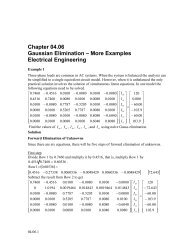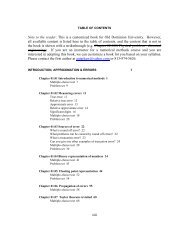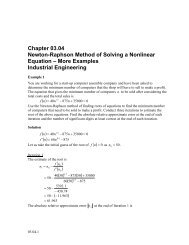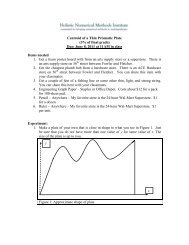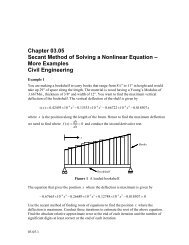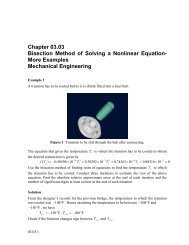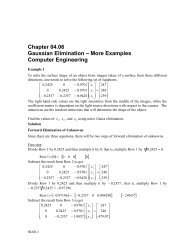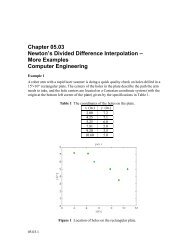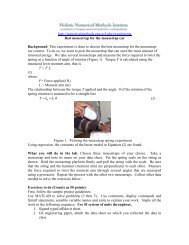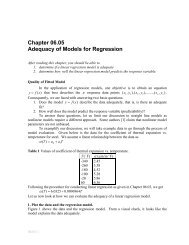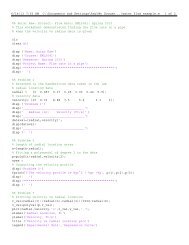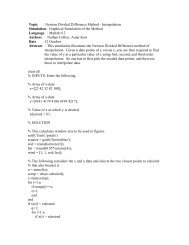Bisection Method of Solving a Nonlinear Equationâ More Examples ...
Bisection Method of Solving a Nonlinear Equationâ More Examples ...
Bisection Method of Solving a Nonlinear Equationâ More Examples ...
Create successful ePaper yourself
Turn your PDF publications into a flip-book with our unique Google optimized e-Paper software.
Chapter 03.03<br />
<strong>Bisection</strong> <strong>Method</strong> <strong>of</strong> <strong>Solving</strong> a <strong>Nonlinear</strong> Equation–<br />
<strong>More</strong> <strong>Examples</strong><br />
Industrial Engineering<br />
Example 1<br />
You are working for a start-up computer assembly company and have been asked to<br />
determine the minimum number <strong>of</strong> computers that the shop will have to sell to make a pr<strong>of</strong>it.<br />
The equation that gives the minimum number <strong>of</strong> computers n to be sold after considering the<br />
total costs and the total sales is<br />
1.5<br />
f ( n)<br />
40n<br />
875n<br />
35000 0<br />
Use the bisection method <strong>of</strong> finding roots <strong>of</strong> equations to find the minimum number <strong>of</strong><br />
computers that need to be sold to make a pr<strong>of</strong>it. Conduct three iterations to estimate the root<br />
<strong>of</strong> the above equation. Find the absolute relative approximate error at the end <strong>of</strong> each<br />
iteration and the number <strong>of</strong> significant digits at least correct at the end <strong>of</strong> each iteration.<br />
Solution<br />
Let us assume<br />
n <br />
50,<br />
nu<br />
100<br />
Check if the function changes sign between n<br />
and nu<br />
.<br />
1.5<br />
f ( n<br />
) f 50<br />
40(50) 875(50) 35000 5392. 1<br />
1.5<br />
f(n u<br />
) f (100) 40(100) 875(100) 35000 12500<br />
Hence<br />
f n<br />
f<br />
nu<br />
<br />
f 50f<br />
100<br />
5392.1<br />
12500 0<br />
So there is at least one root between n<br />
and nu<br />
, that is, between 50 and 100.<br />
Iteration 1<br />
The estimate <strong>of</strong> the root is<br />
n nu<br />
nm<br />
2<br />
50 100<br />
<br />
2<br />
75<br />
n f<br />
n f n<br />
1.5<br />
3<br />
75<br />
40(75) 875(75) 35000 4.644210<br />
f<br />
m<br />
f<br />
3<br />
<br />
f 50f<br />
75<br />
5392.1<br />
4.644210<br />
0<br />
<br />
m<br />
03.03.1
03.03.2 Chapter 03.03<br />
Hence the root is bracketed between n<br />
and nm<br />
, that is, between 50 and 75. So, the lower<br />
and upper limits <strong>of</strong> the new bracket are<br />
50,<br />
n 75<br />
n <br />
u<br />
At this point, the absolute relative approximate error<br />
have a previous approximation.<br />
Iteration 2<br />
The estimate <strong>of</strong> the root is<br />
n nu<br />
nm<br />
2<br />
50 75<br />
<br />
2<br />
f<br />
f<br />
62.5<br />
n f<br />
1.5<br />
<br />
m<br />
62.5<br />
40(62.5) 875(62.5) 35000 76. 735<br />
n<br />
f<br />
n<br />
<br />
f 50f<br />
62.5<br />
5392.1 76.735 0<br />
<br />
m<br />
<br />
a<br />
cannot be calculated, as we do not<br />
Hence, the root is bracketed between nm<br />
and nu<br />
, that is, between 62.5 and 75. So the lower<br />
and upper limits <strong>of</strong> the new bracket are<br />
62.5,<br />
n 75<br />
n <br />
u<br />
The absolute relative approximate error,<br />
<br />
a<br />
<br />
n<br />
new<br />
m<br />
n<br />
n<br />
new<br />
m<br />
old<br />
m<br />
100<br />
a<br />
at the end <strong>of</strong> Iteration 2 is<br />
62.5 75<br />
100<br />
62.5<br />
20%<br />
None <strong>of</strong> the significant digits are at least correct in the estimated root<br />
n m<br />
62.5<br />
as the absolute relative approximate error is greater that 5%.<br />
Iteration 3<br />
The estimate <strong>of</strong> the root is<br />
n nu<br />
nm<br />
2<br />
62.5<br />
75<br />
<br />
2<br />
68.75<br />
1.5<br />
f n f 68.75<br />
40(68.75) 875(68.75) 35000 2.354510<br />
f<br />
<br />
3<br />
m<br />
3<br />
n<br />
f<br />
n<br />
<br />
f 62.5f<br />
68.75<br />
76.735<br />
2.354510<br />
0<br />
<br />
m<br />
Hence, the root is bracketed between n<br />
and nm<br />
, that is, between 62.5 and 68.75. So the<br />
lower and upper limits <strong>of</strong> the new bracket are<br />
62.5,<br />
n 68.75<br />
n <br />
u<br />
The absolute relative approximate error<br />
<br />
a<br />
at the end <strong>of</strong> Iteration 3 is
<strong>Bisection</strong> <strong>Method</strong>-<strong>More</strong> <strong>Examples</strong>: Industrial Engineering 03.03.3<br />
<br />
a<br />
<br />
n<br />
new<br />
m<br />
n<br />
n<br />
new<br />
m<br />
old<br />
m<br />
100<br />
68.75 62.5<br />
<br />
100<br />
68.75<br />
9.0909%<br />
Still none <strong>of</strong> the significant digits are at least correct in the estimated root <strong>of</strong> the equation, as<br />
the absolute relative approximate error is greater than 5%. The estimated minimum number<br />
<strong>of</strong> computers that need to be sold to break even at the end <strong>of</strong> the third iteration is 69. Seven<br />
more iterations were conducted and these iterations are shown in the Table 1.<br />
Table 1 Root <strong>of</strong><br />
f<br />
x<br />
0<br />
as a function <strong>of</strong> the number <strong>of</strong> iterations for bisection method.<br />
Iteration<br />
1<br />
2<br />
3<br />
4<br />
5<br />
6<br />
7<br />
8<br />
9<br />
10<br />
n<br />
50<br />
50<br />
62.5<br />
62.5<br />
62.5<br />
62.5<br />
62.5<br />
62.5<br />
62.5<br />
62.598<br />
nu<br />
100<br />
75<br />
75<br />
68.75<br />
65.625<br />
64.063<br />
63.281<br />
62.891<br />
62.695<br />
62.695<br />
n %<br />
m<br />
75<br />
62.5<br />
68.75<br />
65.625<br />
64.063<br />
63.281<br />
62.891<br />
62.695<br />
62.598<br />
62.646<br />
f <br />
a<br />
----------<br />
20<br />
9.0909<br />
4.7619<br />
2.4390<br />
1.2346<br />
0.62112<br />
0.31153<br />
0.15601<br />
0.077942<br />
n m<br />
4.644210<br />
76.735<br />
2.354510<br />
1.156910<br />
−544.68<br />
−235.12<br />
−79.483<br />
−1.4459<br />
37.627<br />
18.086<br />
3<br />
3<br />
3<br />
th<br />
10<br />
At the end <strong>of</strong> the iteration,<br />
a<br />
0.077942%<br />
Hence the number <strong>of</strong> significant digits at least correct is given by the largest value <strong>of</strong><br />
which<br />
2m<br />
0 .510<br />
So<br />
a<br />
2m<br />
0.077942 0.510<br />
2m<br />
0 .15588 10<br />
log0.15588 2 m<br />
m 2 log 0.15588 2.<br />
m 2<br />
8072<br />
The number <strong>of</strong> significant digits at least correct in the estimated root 62.646 is 2.<br />
m<br />
for
03.03.4 Chapter 03.03<br />
NONLINEAR EQUATIONS<br />
Topic <strong>Bisection</strong> <strong>Method</strong>-<strong>More</strong> <strong>Examples</strong><br />
Summary <strong>Examples</strong> <strong>of</strong> <strong>Bisection</strong> <strong>Method</strong><br />
Major Industrial Engineering<br />
Authors Autar Kaw<br />
Date August 7, 2009<br />
Web Site http://numericalmethods.eng.usf.edu



